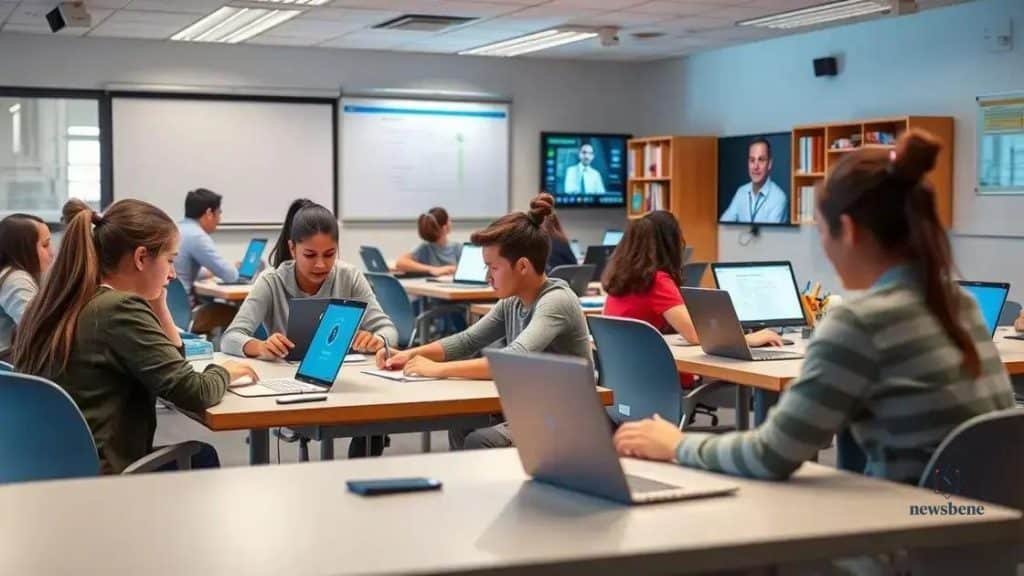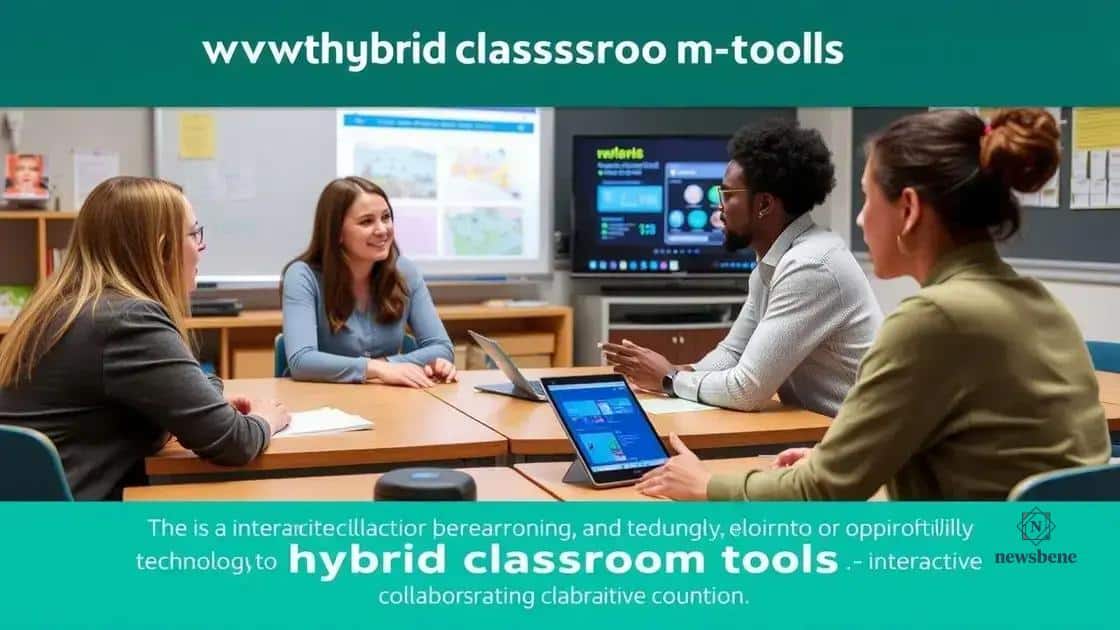Hybrid classroom tools: revolutionizing education today

Anúncios
Hybrid classroom tools enhance education by combining in-person and online learning, increasing accessibility, engagement, and personalized experiences for students.
Hybrid classroom tools are changing the way we think about education. Imagine being able to learn from anywhere while still engaging with peers and instructors. This approach not only enhances accessibility but also enriches the learning experience. Let’s dive into how these tools are reshaping classrooms today.
Anúncios
What are hybrid classroom tools?
Hybrid classroom tools are innovative technologies that blend in-person and online learning experiences. They allow students and teachers to interact in both physical and virtual environments, enriching the educational process.
These tools have gained popularity as they cater to different learning styles. With the rise of technology in education, the use of hybrid classroom tools has become essential for modern teaching methods.
Types of Hybrid Classroom Tools
Anúncios
There are various types of hybrid classroom tools available for educators. Each tool offers unique features that enhance the learning experience.
- Video conferencing platforms like Zoom and Microsoft Teams
- Learning management systems (LMS) such as Moodle and Canvas
- Collaboration tools like Google Workspace and Microsoft 365
- Interactive whiteboards for engaging presentations
These tools facilitate smoother communication and provide a platform for sharing resources among students and teachers. For instance, a video conferencing tool allows live interactions, while an LMS keeps track of assignments and progress.
Benefits of Using Hybrid Classroom Tools
The adoption of hybrid classroom tools presents numerous benefits. These tools not only help in enhancing student engagement but also encourage flexible learning. Students can learn at their own pace, accessing materials online whenever needed.
- Increased accessibility for students
- Opportunities for personalized learning
- Strengthened communication between educators and learners
Furthermore, hybrid tools provide valuable insights through data analytics. Educators can track performance and adjust teaching methods accordingly. This data-driven approach leads to improved learning outcomes while keeping students motivated.
As education evolves, embracing hybrid classroom tools becomes crucial. By incorporating these technologies, schools can create dynamic learning environments that meet the ever-changing demands of today’s students.
Benefits of using hybrid classroom tools
Using hybrid classroom tools offers many advantages that enhance the learning experience for both students and teachers. These tools combine the best aspects of traditional and online education, creating a flexible learning environment.
One major benefit is increased accessibility. Students can participate in lessons from anywhere, which is particularly important for those who may need to stay home or who live far from school. By eliminating physical barriers, more learners can engage in quality education.
Enhanced Engagement
Another advantage is that hybrid tools promote higher levels of engagement. Students can interact with lessons using various formats, such as videos, discussions, and hands-on activities.
- Interactive platforms keep students focused.
- Real-time feedback helps them stay motivated.
- Diverse resources cater to different learning styles.
Moreover, these tools help create a sense of community. Even in a mixed environment, students can connect with peers through online discussion forums and group projects. This social interaction builds relationships and keeps them engaged in the learning process.
Personalized Learning
Hybrid classroom tools also enable personalized learning experiences. Educators can tailor lessons to meet individual needs, ensuring that each student advances at their own pace.
- Adaptive learning technologies assess student performance.
- Customized resources provide targeted support.
- Self-paced learning fosters independence.
This customized approach not only boosts confidence but also encourages students to take ownership of their education. As they work through material that aligns with their interests and skills, they become more invested in their progress.
Finally, using hybrid classroom tools prepares students for the future. In a world increasingly reliant on technology, being comfortable with various digital tools is crucial for success in higher education and the workforce.
How to implement hybrid classroom tools

Implementing hybrid classroom tools requires careful planning and execution. Schools and educators must consider various factors to ensure that these tools work effectively for all students.
The first step is to assess the needs of both students and teachers. Understanding their preferences and challenges will help in selecting the right tools. It’s essential to involve educators in the decision-making process, as they can provide valuable insights into what will enhance their teaching experience.
Choosing the Right Tools
When selecting tools, consider a combination of hardware and software that will best support a hybrid learning environment.
- Video conferencing tools for live interactions.
- Learning management systems (LMS) to organize coursework.
- Collaboration platforms to encourage teamwork.
- Devices, such as tablets or laptops, to facilitate online access.
It’s important to pilot these tools in a small setting first. Gathering feedback from both teachers and students during this trial phase can help identify any technical issues or usability concerns.
Training and Support
Training staff is crucial for a successful transition. Provide comprehensive training sessions to ensure that teachers feel comfortable using the new tools. Offer ongoing support for troubleshooting and answering questions.
- Organize workshops to demonstrate key features.
- Create user guides and resources for reference.
- Establish a help desk for immediate assistance.
Additionally, engaging students in learning about these tools is vital. Encourage students to experiment and use technology in their tasks. This hands-on approach makes them feel more confident in a hybrid setting.
Finally, monitor and evaluate the implementation process. Collect feedback and analyze performance data to see what works and what doesn’t. Adjust strategies as necessary to improve the overall learning experience.
Best practices for hybrid learning environments
In hybrid learning environments, adopting best practices is essential for maximizing educational outcomes. By combining both in-person and online strategies effectively, teachers can create a dynamic learning atmosphere.
One key practice is to establish clear communication channels. Students need to know how to reach their teachers and peers, both in and out of the classroom. Setting up dedicated platforms for announcements, discussions, and feedback can enhance communication.
Structured Scheduling
Another important aspect is implementing a structured schedule. This helps students understand when to engage online and when to be present in class.
- Use a consistent timetable for live sessions.
- Incorporate breaks to maintain student focus.
- Provide timelines for assignments and projects.
Structured scheduling not only aids in time management but also promotes a balance between various learning activities.
Interactive Learning Activities
Utilizing interactive learning activities can significantly enhance student engagement. These activities can be tailored for both in-person and online formats.
- Incorporate group projects that encourage collaboration.
- Use polls and quizzes to gauge understanding.
- Facilitate virtual discussions to include all students.
Engagement increases when students can participate actively in their learning. This approach helps them feel more connected to the material and each other.
Equally important is providing resources and support. Ensure that students have access to the necessary tools and materials to succeed in a hybrid setting. Offering technical support will also help alleviate any frustrations they may face.
Finally, regular feedback is critical in a hybrid environment. Implementing a system for continuous feedback allows students to understand their progress and areas for improvement. This not only fosters a growth mindset but also helps in tailoring instruction to meet their needs.
Future trends in hybrid classroom technology
The future of hybrid classroom technology is set to evolve rapidly, integrating more innovations that enhance learning experiences. As technology advances, educators and students will benefit from new tools that simplify the educational process.
One significant trend is the increasing use of artificial intelligence (AI) in hybrid classrooms. AI can provide personalized learning experiences, adapting lessons to meet the individual needs of each student.
Adaptive Learning Systems
Adaptive learning systems will become a crucial part of hybrid education. These systems adjust content based on student performance, helping them grasp difficult concepts.
- They offer real-time feedback to enhance understanding.
- Students can progress at their own pace, making learning more effective.
- Analytics help teachers identify areas where students struggle.
This targeted approach leads to improved academic results and boosts student confidence.
Virtual Reality and Augmented Reality
Another exciting development is the use of virtual reality (VR) and augmented reality (AR) in learning environments. These technologies provide immersive educational experiences that can bring lessons to life.
- VR can simulate real-world scenarios for hands-on learning.
- AR overlays digital information in physical spaces, enhancing engagement.
- Students can explore complex topics that might be challenging to visualize.
By incorporating these technologies, educators can foster deeper understanding and curiosity among students.
Furthermore, the growth of online resources will continue to shape the hybrid classroom. More open educational resources (OER) will be available, giving students access to high-quality materials from anywhere in the world.
As collaboration tools advance, communication between students and teachers will become even more seamless. Platforms that allow for interactive discussions will enhance student participation, making learning a more collective effort.
Lastly, institutions will increasingly invest in training teachers to use these new technologies effectively. Professional development programs focused on hybrid learning strategies will be essential for maximizing the benefits of new tools.
FAQ – Frequently Asked Questions About Hybrid Classroom Tools
What are hybrid classroom tools?
Hybrid classroom tools combine in-person and online learning, allowing students to engage with educational content from various locations.
What benefits do hybrid classroom tools provide?
They enhance accessibility, increase student engagement, and allow for personalized learning experiences tailored to individual needs.
How can schools implement hybrid classroom tools effectively?
Effective implementation includes assessing needs, choosing the right tools, training staff, and providing ongoing support for both teachers and students.
What future trends should we expect in hybrid classroom technology?
Future trends include the integration of AI for personalized learning, the use of VR and AR for immersive experiences, and improved collaboration tools.